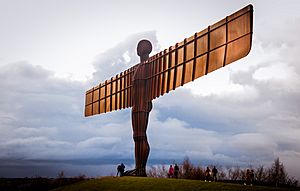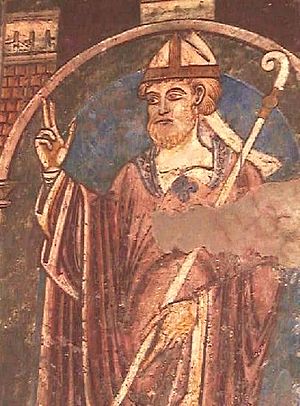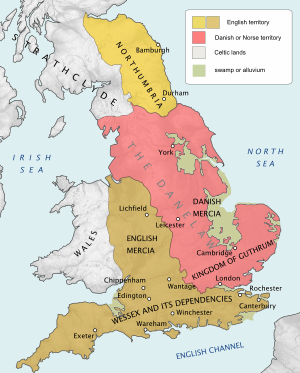Northumbria (modern) facts for kids
Quick facts for kids
Northumbria
|
||
|---|---|---|
|
Region
|
||

|
||
|
||
| Etymology: Old English “Norþanhymbre” meaning "the people or province north of the Humber". | ||

Dark red marks Northumberland and Durham, which formed the late medieval rump earldom of Northumbria. Light red marks English counties that were part of the Kingdom of Northumbria at its height of power in the 8th century.
|
||
| Sovereign state | United Kingdom | |
| Country | England | |
| Region | North East England | |
Northumbria is a special region in England. Today, it usually means the area between the Tees and Tweed. This includes the old counties of Northumberland and Durham. Sometimes, people use "Northumbria" to mean the whole North East England region.
This area was once part of a much larger historical place called the Kingdom of Northumbria. Later, it became the county of Northumberland. The southern border of this old county was the River Tees. There is even a special flag for Northumbria that has been officially registered.
Contents
What is Northumbria?
The exact meaning of "Northumbria" can change. But it usually focuses on the historic counties of Northumberland and Durham. It can also mean the modern counties of Northumberland, Durham, and Tyne and Wear. Sometimes, parts of historic Yorkshire are also included.
Many groups and businesses use "Northumbria" in their names. This shows how important the region is. For example:
- Northumbria Police covers Northumberland and Tyne and Wear.
- Northumbria University is a well-known university.
- The Natural History Society of Northumbria focuses on the North East.
- Northumbria Healthcare NHS Foundation Trust serves historic Northumberland.
- Northumbrian Water provides water services to North East England.
Northumbria's Past: A Journey Through Time
Northumbria has a very long and interesting history. Many important events happened here, shaping the region we see today.
Roman Times in Northumbria
Hadrian's Wall was a famous border of the Roman Empire. You can still find many Roman remains across North East England. There's a special museum at the Roman Fort of Segedunum in Wallsend. It shows many Roman items found along Hadrian's Wall. The Great North Museum Hancock in Newcastle also has a large collection.
Two churches, St. Peter's Church in Sunderland and St Paul's in Jarrow, are very old and important. They are trying to become a World Heritage Site.
The Anglo-Saxons and Vikings
Northumbria has a strong religious past. Famous works like the Lindisfarne Gospels and the Anglo-Saxon Chronicle come from here. Important saints like Cuthbert (634–687 AD), Bede (673–735 AD), and Hilda of Whitby (614–680 AD) lived and worked in this area. They were very important in the early church.
These saints are linked to monasteries on Lindisfarne island, Wearmouth-Jarrow, and Whitby. Bede is known as the greatest Anglo-Saxon scholar. He translated many books on different topics. His most famous work is "The Ecclesiastical History of the English People". The Lindisfarne Gospels are a beautiful piece of art and writing. A monk named Eadfrith likely created them around 710–720.
At its largest, the Anglo-Saxon Kingdom of Northumbria was huge. It stretched from the Scottish borders in the north to south of York, its capital. On June 6, 793, Vikings attacked the monastery on Lindisfarne. This was a terrible event. For 300 years, Vikings raided, fought, and settled in the area. This continued until William the Conqueror won the Battle of Hastings in 1066.
In 866, Ivar the Boneless captured lands between the Humber and Tees. He started the Scandinavian Kingdom of York. The lands north of the Tees stayed under Anglian rule. The Earls of Bamburgh ruled the lands north of the Tyne. The Community of St. Cuthbert ruled between the Tyne and Tees. Both groups saw themselves as the true heirs of Northumbria.
The Anglo-Saxon Chronicle notes that in 876, Vikings "Shared out the land of the Northumbrians and they proceeded to plough and support themselves." However, most Viking settlement was south of the Tees. There is not much evidence of Viking names in County Durham and Northumberland.
By 954, the West Saxon Kings took over the Kingdom of York. They made it part of the new English kingdom. The lands north of the Tees stayed under local rulers. After the Scottish victory at the Battle of Carham in 1018, Northumbria's northern border became the Tweed. By the end of the Anglo-Saxon era, "Northumbria" only meant the region between the Tweed and Tees.
Normans and the Formation of Counties
After the Norman conquest, the County of Northumberland was formed. It covered all of north-eastern England between the Tweed and Tees. This county included special areas where the king's rules did not fully apply. One important area was the Liberty of Durham. It was largely independent under the Bishops of Durham.
In 1293, the Bishop of Durham said that Durham was not part of any English county. This was accepted, and Durham became known as the "County Palatine of Durham." This meant the bishop acted like a private sheriff. Over time, the region was divided into two separate counties: Northumberland and the County Palatine of Durham.
These two counties acted as important buffer zones between England and Scotland. They had their own ways of governing. Durham was almost like a semi-independent state. Northumberland was more open to Scottish attacks.
Northumbria in Modern Times
The idea of "Northumbria" as a distinct region grew in the 1800s. People in the North East wanted to show their unique history. They looked back to the old Kingdom of Northumbria for inspiration. Groups like the Surtees Society were formed to study the history of Durham and Northumberland.
This movement also led to a unique "Northumbrian" musical style. It was different from other English folk music. Today, "Northumbria" is a respected name for the region. However, it is not the official name for the UK region of North East England.
The idea of a modern Northumbria became official in the late 1900s. Many regional groups adopted the name. These include the Northumbria Tourist Board, Northumbria Police, Northumbria University, and Northumbrian Water.
Northumbrian Culture
Northumbrian culture shares some things with both England and Scotland. But it also has many unique traditions found only in this region.
Music and Folklore
Northumbria is famous for its special music. It has its own unique instrument, the Northumbrian smallpipe. The region is also known for folk arts like Durham/North Country Quilting and horn stick work. These arts became popular in the 1800s and early 1900s.
Northumbria has its own tradition of Christian saints. St. Cuthbert is especially important. Every year, people celebrate St. Cuthbert's day. They walk from Chester-le-Street to Durham and have a procession.
Northumbrian Folk Music
Northumbria has a unique style of folk music. It features border ballads and the use of the Northumbrian smallpipes. The fiddle tradition was also very strong here by the late 1600s.
The Blaydon Races
The Blaydon Races is a very popular song. Geordie Ridley first sang it in Newcastle in 1862. The song describes the people who went to these old horse races. The races were held on an island in the River Tyne. The last race was on September 2, 1916. A riot happened after a horse was disqualified, and the races stopped. The song and the event are shown in William Irving's 1903 painting, "The Blaydon Races – A Study from Life." You can see it at the Shipley Art Gallery in Gateshead.
Northumbrian Folklore: Worms and Knights
"Worms" are a common part of Northumbrian folklore. The word "worm" comes from the Old Norse word ‘ormr’, meaning a serpent or dragon. Famous examples include the Lambton Worm, Sockburn Worm, and Laidly Worm of Spindleston Heugh. These legends often tell of a knight returning home from war to defeat one of these creatures.
Northumbria's Natural World: Plants and Animals
Northumbria has a very diverse landscape. It includes tall sea cliffs and large areas of moorland. These places are home to many rare species of flora (plants) and fauna (animals).
Important Natural Habitats
The saltmarshes of Lindisfarne and the Tees Estuary are very important. So are the heaths, bogs, and old hay meadows of the North Pennines. Upper Teesdale has special Arctic-alpine plants.
The beautiful Northumbrian coastline is a designated area of outstanding natural beauty (AONB). It stretches for 100 miles from Berwick-Upon-Tweed to the River Coquet estuary.
Amazing Wildlife
The Farne Islands are home to 290 bird species, including the rare seabird the roseate tern. "Saltholme" is a top bird sanctuary and observatory for migratory and wading birds in the UK. It's part of a larger site called Seal Sands. The Saltholme reserve is managed by the Royal Society for the Protection of Birds(RSPB). Famous bird watcher Bill Oddie called it one of the best places to see birds.
The seal colony at Seal Sands, near the mouth of the River Tees, is doing very well. It has over 60 harbour seals. This is the only breeding colony of this type of seal on the northeast coast. "Rainton Meadows" is another new bird-watching spot.
Northumbria is also the main home in England for black grouse. It has 80–90% of the UK's population of yellow marsh saxifrage.
The Magnesian Limestone grasslands of East Durham are unique. They are found nowhere else in the world. They are very important for many types of butterflies and moths.
The North East of England also has large forests. Kielder Forest is the biggest man-made forest in Europe. It is in Northumberland National Park. This forest is a vital home for the endangered red squirrel.




